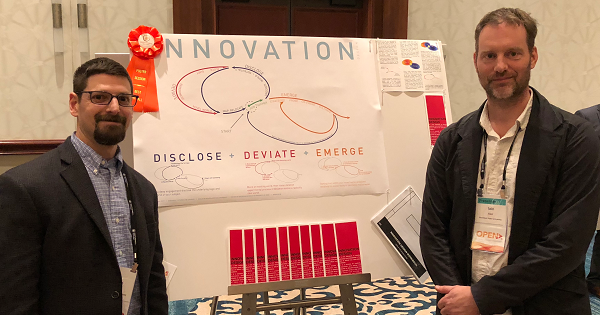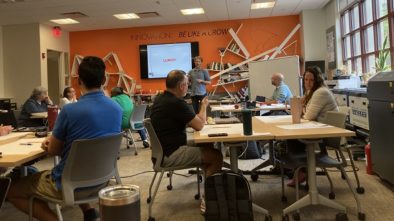Interview: Iain Kerr and Jason Frasca Discuss Their New Book, “Innovating Emergent Futures”
Jason Frasca has been a member of the New Jersey entrepreneurial community for many years, helping to found startup communities and a coworking space in the last decade. Later, he became co-director of the MIX (Making & Innovating for X) Lab, a 3-D printing and innovation hub at Montclair State University’s Feliciano Center for Entrepreneurship and Innovation. Iain Kerr, Jason’s co-director at the MIX Lab, is a thought leader in the field of innovation, and he brought his research and brand of innovation to the lab. Both authors are professors of entrepreneurship and innovation at Montclair State University.
In 2018 Kerr and Frasca founded the Emergent Futures Lab (Clinton) as an innovation consultancy and platform for rethinking creativity, invention and change. Together, the two developed a new, dynamic way of looking at innovation, and they wrote the book “Innovating Emergent Futures: The Innovation Design Approach for Change and Worldmaking.”
Tell me about your backgrounds.
iain: I’m originally from Vancouver. That really shaped me: A lot of time in the outdoors and being part of a culture that is connected more to the Pacific rim than to Europe.
jason: I grew up in the New York City Metro area. I’ve always been fascinated and interested in systematizing processes improvement. And I have been involved in a number of ventures and jobs where resources have been limited. Those constraints have driven Innovation process and novel solutions to problems that I never would have otherwise considered.
iain: I’m also really interested in that systems perspective from having studied architecture and being involved a lot in “how do you” innovate [discussions and projects] at different scales and with different community groups and organizations around things like urban planning and ecology in the arts.
So, I think that’s where we meet each other — thinking about what’s the innovation process? What’s the innovation system? What are all the parts? Don’t get lost in any one detail.
jason: We believe in the acceptance and embracing of the long view: that innovation is slow. There are no quick answers or quick fixes. But I found in working together that our backgrounds mesh in that moment. It’s a constant flow of iteration working and evolving, learning, sharing — over and over again until we get to some interesting place.
iain: That’s so true. It’s the innovation paradox: You have to go slow to go fast. Fast is like the illusion of innovation that people have wrong.
How did you get the idea for this book?
iain: We’ve always been thinking about it over the last 20 plus years. As we did things and we saw that the standard ways people are framing innovation really didn’t work, we tried different ideas until …
jason: … Until the summer of 2016, we’re sitting in the lab debating innovation, creativity and the fact that our students’ projects in our entrepreneurial program were all just widgets.
In examining that more deeply, the pillar of design thinking upon which our curriculum was built was really leading us in to “widgetized” outcomes that our students were not particularly excited about — nor were we as educators.
I remember us debating this — it was summertime and we went deep over several days and weeks. We ended up going to the bookshelf to review all of the entrepreneurial startup creativity and innovation books we had that supported the program. All they had was one sentence, stating emphatically the importance of creativity and innovation, but they never said how to innovate, or be creative. Nobody had a solution or process; they all went right on into the next part of the process for the entrepreneurship or startup element.
Then looking more deeply, even in the index, there was never a mention of the words again. I think that was the impetus. That was the moment that drove us to write this book.
iain: It’s truly crazy that everyone talks about innovation, but nobody tells you how to do it. And that they just leap over that. If it’s important, there’s got to be a method to it — that’s what’s really been driving all of our work: There’s a method to innovation (and it’s not what people think it is).
In terms of innovation, we’ve lived this experience — We’ve not only used and tried out every method out there, we’ve then gone back to the foundations and figured out for ourselves what is innovation? How does it actually happen? And try to come up with alternatives.
We’re not coming at it from a theoretical perspective, as armchair philosophers, or armchair neurologists or historians of innovation. We know all of these things because we’re practitioners. And we want people to achieve results — impactful outcomes.
jason: As practitioners, we’ve practiced our Innovation process, model and approach, with industry, with students, in academia, at conferences. We’ve been workshopping this for years.
How did you go about gathering material for this book?
iain We have, in a sense, been writing this book over the last 20 years. We started by going over all the notes we took during previous work situations, during workshops and conferences. We came up with something, then we tore it apart after testing it with groups, workshops and students, and finding that we had written it the wrong way. The book emerged organically from our community of collaborators, and now will go back out to them to be the start of a discussion and dialog.
jason: I would add in terms of gathering material for this book — while we have very complementary skill sets, a significant area of overlap is we’re both diligent note takers. And that we had thousands and thousands of notes and notebooks to refer to in trying to answer the question: how to innovate.
We’d been thinking about it, subconsciously and then consciously, in more recent years. And the material is a combination of research and reading and analyzing how and why companies have succeeded and failed due to embracing or neglecting innovation.
Who should read the book, and why?
iain: I think you should read it If you have a pressing question, if you feel the urgency to do something about something, if you’re curious about making change happen. It’s really designed to be a hands-on practical book to help people. And we developed it deliberately to help businesses, entrepreneurs, community groups and individuals. Each of them could come to this book from their own perspective and find that it speaks to them. It flexes with, and it supports them, through their own unique innovation journeys. And it really delivers innovation possibilities and actual practical outcomes.
jason: The people who should read this book are those that are quite tired of sticky-note brainstorming sessions and idea-management software solutions. You’ve probably tried them in your organization. Or your superiors have imposed them upon you as ways to be creative and innovate — as ways to solve your biggest, most vexing problems and challenges in your work, company or industry, such as creating differentiation from competition. And all you end up with is the standard idea box. But that’ll never get an organization or a company to novel disruptive innovation and product differentiation.
Novel disruptive innovation is required in 2021 to manage and handle the greatest challenges that humanity’s ever faced: our climate crises, our social crises and urgencies and problems related to resources and balanced growth.
As innovation consultants, our goal is to help transform organizations with a holistic systemic approach — those who are looking for an innovation process that will drive paradigmatic change — and embed innovation within them. This will help organizations where those sticky-note brainstorming sessions have left them looking for alternative approaches and answers.
Is there anything else you would like people to know about this book?
jason: I think what’s really important to know is that it’s not simply a book you read cover to cover, sharing philosophy, research and understandings of what innovation is, because we didn’t think that would be enough. To truly answer the question of how to innovate, the second half of the book Is a workbook. It’s a book that you engage to help you answer real innovation challenges.
iain: I would say the other important thing that we’ve hinted at with the book is that it’s more than a book. It’s a platform for discussion. It’s got QR-coded links to online information, and a platform for ongoing conversations. So, it’s really about building a community capacity around innovation and change-making. That’s what we are aiming for. So, we’d love you to buy the book and join the community and collaborate with us.
Please give readers three takeaways from the book.
iain: The first big takeaway is that our society focuses far too much on ideation, coming up with great ideas, and we do not spend enough on the process of experimentation — a process that will lead eventually to entirely different ways of approaching things, astonishing outcomes and, eventually, amazing ideas.
The second is: Stop focusing on solutions (and outcomes and products). They’ll happen If you let them. We really need to be focusing on developing novel frameworks, different worldviews, and understanding that the outcome of innovation is a novel world. Innovation is not about solving problems but novel worldmaking.
The third thing is that innovation is a process — and that you must understand the whole process and then trust it. Innovation is not about a single moment of just coming up with a creative idea and then figuring out how to make it real. It’s a more deliberate step-by-step sequential process that you need to follow and trust.
jason: I’ll just add one more, which is: The answers we give to the question “What is innovation?” are backed by science. We are looking at cutting-edge research in embodied cognition, evolutionary theory, dynamic systems thinking and the new science of materials and theories of emergence to help lead us to novelty.
Can you give us two quotes from the book?
1.The first one is a bit of a teaser (you need to read the book to see how we avoid this problem): “Here is where the central problem lies with “ideation first” models of creativity: the modes of thinking that ideation relies on are high concept and representation dependent. … Ideation is thus inherently tied to the past and what already exists. And if it already exists it cannot be considered to be novel, which means: ideation cannot directly lead to novelty. … Put bluntly: if something is genuinely novel it cannot at first be conceptualized…”
2. “If creativity is not pre-existing in the head, then it depends wholly on practice — why some people are more ’creative’ than others is simply because they have practiced and fully embodied the key techniques of the innovation process. This goes for organizations, collectives, and events — practice matters.”




